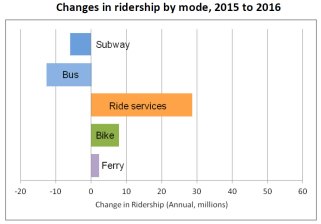Sustainable Transportation for NYC: How to Make it Happen
Today on Gotham Gazette, Bruce Schaller outlines how transportation policy could fit in to Mayor Bloomberg’s sustainability initiative for 2030. The piece merits a full read, but Schaller frames his argument in terms of three big ideas:
[F]ix the skewed economic incentives to drive, implement targeted transit improvements throughout the city, and make more efficient use of the limited street space in congested areas.
Schaller argues that tightly targeted congestion pricing could find political support in New York. But he adds that it has to be part of a bigger solution:
The main problem with congestion pricing is the tendency to think that this one big idea is sufficient. New Yorkers are actually very sophisticated about the multifaceted nature of the traffic problem. They know that traffic congestion has many causes, and that it’s a citywide problem, so congestion pricing by itself is not enough….
The key to making congestion pricing work is to bolster the public transportation system, especially in areas where many people use their cars. That means far better express bus service from outlying areas of the city. It means figuring out how to make the commuter railroads a meaningful part of the city’s transit system. It means adding options for drivers such as park and ride lots. And it means spreading pricing strategies outside Manhattan, in particular, through tolled express lanes on outer borough highways.
The growth of the city also means adding rail capacity to handle the additional riders. While the Second Avenue subway and #7 extension will add new track mileage to the system, cost makes system expansion an inherently limited approach. Through technology such as computer-based train control systems, however, the effective passenger capacity of existing lines can be enlarged by increasing the number of trains that can be operated through the system. The MTA is slowly implementing these new train control systems. Speeding up that implementation could expand capacity of overcrowded lines in a matter of years instead of decades.
All of this will take money, lots of money, and that’s where the second big idea comes in. The mayor will need to make a grand deal with the MTA and Port Authority on how the congestion fees are collected, who gets them, what it pays for and how the use of the money is guaranteed for the promised purposes. That grand deal would be another Bloomberg legacy.
Schaller goes on to make a strong case for experimentation rather than endless examination of the problems.
Finding the right balance is difficult, but studies aimed at finding that balance too easily lead to paralysis by analysis. The city has shown it knows a better way, as when it has implemented traffic plans for a limited period such as during the holiday season, and during the transit strike, or in a limited area such as the initial Midtown commercial parking Muni-meter program. The genius of these plans is that they are either temporary or limited in scope, so they do not undergo the time-consuming reviews to which more ambitious plans are subject….
Why not try some seemingly good ideas on a pilot basis? Measure the outcomes. Then decide whether and where to apply them permanently. Armed with real-life results, the required studies should go faster and be more credible. A host of initiatives are amenable to this approach:
- Raise the price of metered parking to encourage turnover and expand the availability of on street parking.
- Try to make bus lanes actually exclusive to buses by installing "soft" barriers like bollards and truncated domes and "quick curbs."
- Beef up enforcement of traffic rules like don’t-block-the-box and, for taxis, pick up and drop off only at the curb.
- Close Broadway to traffic on Sundays in the summer.
Smaller steps like these, writes Schaller, could add up to "a viral approach to transportation improvements…that can make the mayor’s sustainability plan self-sustaining." But he also cautions that making changes in transportation policy is a dicey business that can be easily thrown off track. After all, ass he rightly points out, "[t]here are plenty of people, some within the mayor’s own administration, who will vehemently defend maintaining the chaotic status quo."

